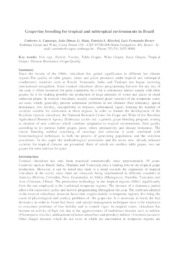Grapevine breeding for tropical and subtropical environments in Brazil.
Grapevine breeding for tropical and subtropical environments in Brazil.
Author(s): CAMARGO, U. A.; MAIA, J. D. G.; RITSCHEL, P. S.; REVERS, L. F.
Summary: Since the decade of the 1960s, viticulture has gained significance in different hot climateregions.The quality of table grapes, wines and juices produced under tropical and subtropicalconditionsin countries such as Brazil, Venezuela, India and Thailand has begun receivinginternational recognition. Since tropical viticulture allows programming harvests for any day ofthe year, it offers prospects for great expansion, be it for a continuous market supply with tablegrapes, be it for making possible the production of large amounts of wines and juices in smallindustrial plants. In tropical viticulture, usually traditional grape varieties of the temperate zonesare used, which, generally, present adaptation problems in hot climates (bud dormancy, apicaldominance, low fertility, susceptibility to diseases, unbalanced vigor), limiting the number ofvarieties suitable for cultivation in these regions. In order to foment the development of theBrazilian tropical viticulture, the National Research Center for Grape and Wine of the BrazilianAgricultural Research Agency (Embrapa) carries out a genetic grape breeding program, aimingat creation of new cultivars which combine adaptation to tropical environments, fruit qualityaccording to its purpose (table grapes, juice, wine), productivity and disease resistance. Theclassic breeding method consisting of crossings and selection is used, combined withbiotechnological techniques in both the process of generating populations and the selectionprocedures. In this paper the methodological procedures and the seven new, already releasedvarieties for tropical climates are presented, three of which are seedless table grapes, two aregrapes for wine and two for juice.
Publication year: 2007
Types of publication: Paper in annals and proceedings
Unit: Embrapa Grape & Wine
Keywords: Brasil, Melhoramento genético, Produção, Propagação, Região subtropical, Região tropical, Uva, Variedade, Viticultura
Observation
Some of Embrapa's publications are published as ePub files. To read them, use or download one of the following free software options to your computer or mobile device. Android: Google Play Books; IOS: iBooks; Windows and Linux: Calibre.
Access other publications
Access the Agricultural Research Database (BDPA) to consult Embrapa's full library collection and records.
Visit Embrapa Bookstore to purchase books and other publications sold by Embrapa.

